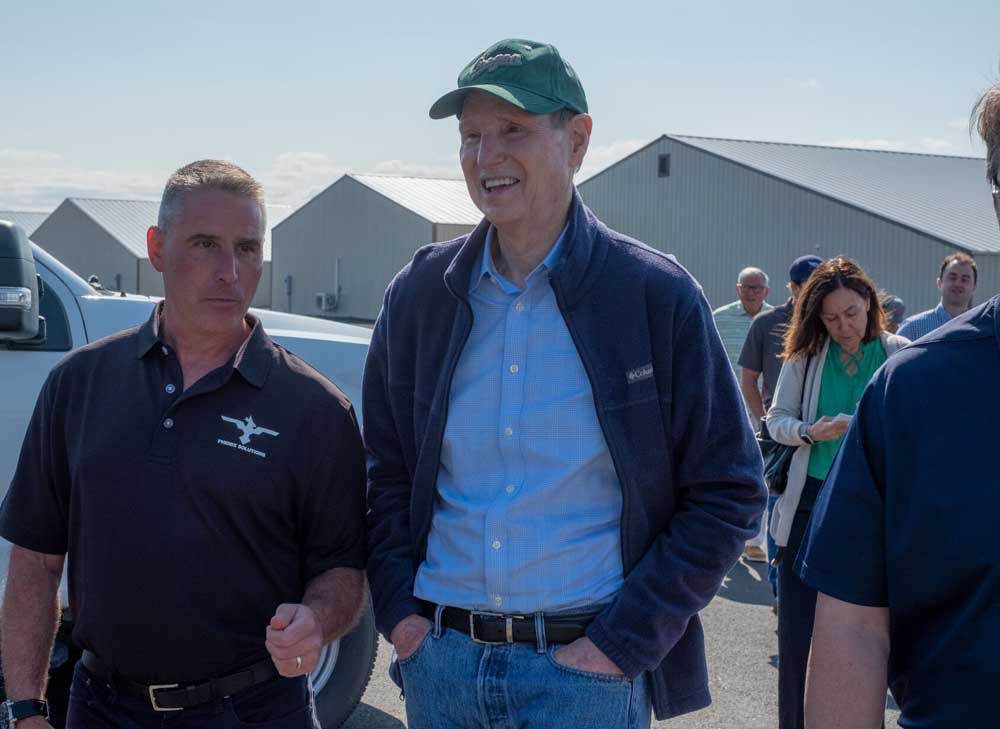Other Views: Drones could deliver big benefits for Eastern Oregon
Published 1:00 pm Thursday, September 19, 2024

- U.S. Sen. Ron Wyden, D-Oregon, center, walks Aug. 25, 2024, with Brian Riese, co-founder of Phenix Solutions Inc., at the Pendleton UAS Range to look at his helicopter drone for fighting fires.
Preparing the flight path in Eastern Oregon for the takeoff of the local unmanned aerial vehicle industry — and the good local jobs it generates — has been years in the making.
The path to this moment began in 2015 when I gathered with Oregonians from the state’s UAV industry to help clear cloudy bureaucratic skies to make manufacturing UAVs here in Oregon a reality.
In 2016, I worked to pass legislation that streamlined the manufacturing permitting process and cleared the industry for growth.
As an early advocate of this fresh technology, I secured three unmanned aerial systems test ranges in Tillamook, Warm Springs and Pendleton. In the 2017 Federal Aviation Administration bill, I ensured these ranges would stay in operation by extending authorization of the UAS program.
Based on what I saw in August at the Unmanned Aerial Systems Accelerator facilities in Pendleton, the future is impressive with UAS Accelerator cohorts such as Advanced Drones LLC; Aerial Industries Pte.; Cyphra Autonomy; Phenix Solutions Inc.; Rangair LLC; Zepher Flight Labs Inc.; and Zing Drone Solutions all leading the way in solving challenges such as wildfires and precision agriculture.
Last week, local UAS leaders showcased their Pendleton-tested UAVs to investment firms from around the world at the “Pendleton Investor Round-Up.” They’ve generated solutions to on-the-ground challenges and have earned a grant from Business Oregon for $2.25 million.
Here is my top-10 list of benefits that could land in Eastern Oregon with continued support of this industry:
10. Enhanced security with domestically manufactured UAVs.
9. A regional reputation for tech ingenuity.
8. Precision agriculture solutions for Eastern Oregon and beyond.
7. Implementation of these agricultural solutions, saving local farmers money, time, fuel and agricultural assets.
6. “Digital license plate” technology will help firefighters and emergency responders identify private drones in restricted airspace and get them out of the way so crucial firefighting can continue.
5. Early wildfire detection in remote areas will help identify fires before they threaten communities.
4. Wildfire suppression solutions: The ability to send UAVs into hazardous situations without risking lives will certainly help keep firefighters, Oregonians and our natural wonders safer, particularly in dangerous and hard-to-reach areas that could take hours to reach by motor vehicle.
3. A trained, local workforce: The need to build up local workforces and create opportunities for young Oregonians is something I’ve heard often in my nearly 1,100 town halls. Because this industry holds so much potential, Blue Mountain Community College is offering a UAS professional pilot two-year degree. Students will be taught how to operate UAVs in national airspace, giving young Oregonians reason and opportunity to keep their roots planted here in Pendleton.
2. Direct and indirect economic impact: The UAS Accelerator facility in Pendleton, one of the country’s busiest drone test ranges, saw more than 23,000 drone activations in 2022. It’s no coincidence Travel Oregon reports the economic impact of Pendleton’s tourism industry jumped 35% in 2022 over prepandemic levels reached in 2021. This boost in economic impact can be tied in part to increased visitation to the UAS Range, with a new Radisson Hotel at the airport helping to meet demand.
1. Lucrative careers outside of Portland: The potential to create good-paying jobs for Oregonians is always on my radar and I was particularly struck with Phenix Solutions Inc. out of McMinnville. Its Ultra 2XL UAV model’s ability to haul heavy loads of water or equipment to aid with emergencies in difficult terrain has already earned it contracts with the U.S. Navy and U.S. Air Force, with potential for much more.
Phenix Solutions is not only innovating with firefighting technology the West Coast so dearly needs in an escalating climate crisis, it’s also creating job opportunities for Oregonians, making it possible for them to buy homes and raise families outside of Portland. Phenix Solutions employs 20 people with an average salary of $123,000; it predicts that number of employees will increase by 50% in 2025.
I am a proud supporter of forward-thinking small businesses like this one and others whose innovation in domestically produced UAVs is sure to land investments and help the local economy soar.


